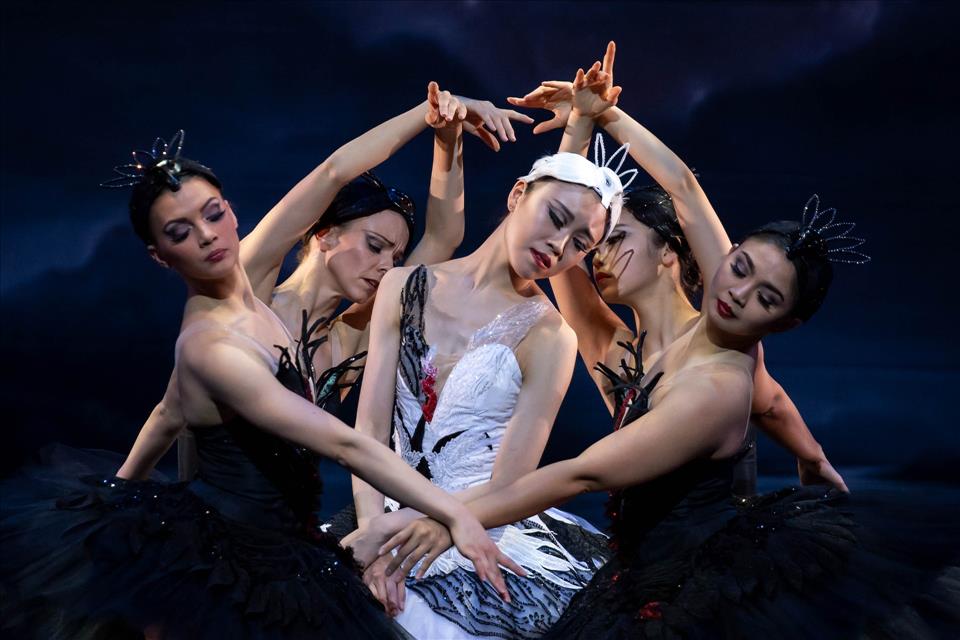(MENAFN- The Conversation) Review: Swan Lake, West Australian Ballet
Opening this production of Swan Lake is the traditional Noongar black swan dance and the song that accompanies it.
Led by Noongar Leader Barry McGuire, the Noongar swan dance from Gya Ngoop Keeninyarra (One Blood Dancers) is a gentle, measured piece.
The five dancers come across in a line, raise their legs into a sharp angle just below the hips and push the leg down precisely – but not with the force of many Indigenous dances.
In this scene, and when they reappear throughout the ballet, each has a flexible bower or rod before their chest which is shaken gently. The nature of this object varies: at one point white feathers fan over the wounded Odette (Kiki Saito); later it is black feathers.
The placing of the Noongar dancers into a snaking line resonates with the later straight lines of ballerinas, such as the ballet's famous cygnet dance, integrating the Noongar dancers into the choreography.
But the Noongar materials are small dramatic interjections into what is otherwise a typical late Romantic ballet. Choreographer Krzysztof Pastor reproduces something familiar with a dash of local flavour.
The European aristocratic Romantic ballet – complete with period costumes, choreographic highlights and most of Tchaikovsky's original score – is lifted out of its original context and into a Western Australian setting. The success or otherwise depends on whether one feels this is desirable or even possible.
This is a familiar ballet, with a dash of local flavour. West Australian Ballet/Bradbury Photography A West Australian story
It is 19th century Perth, rather than Russia. The character of Prince Siegfried becomes Sebastian Hampshire (Oscar Valdés), son of wealthy developer John Hampshire (Christian Luck), and his close friend is now Mowadji (Noongar actor Kyle Morrison).
Changes in story-line come unstuck with the character of Baron von Rothbart, originally a shapeshifting sorcerer, who becomes William Greenwood (Matthew Lehmann).
Although identified of settler descent, he is able to transform into the totemic animal of the waalitj, or wedge tailed eagle, which Noongar scholar Len Collard identifies as the most powerful bird on this Country, a“guardian of both the earth and the sun .”
Greenwood uses his evil avian magic to keep Odette under his spell as a white swan (such as one finds in Europe) until a man declares his love for her.
Greenwood also deploys Odile (sometimes played as Odette's other self, but here a distinct character, peerlessly danced by Chihiro Nomura) the task of wooing Sebastian so Greenwood might join his dynasty with Sebastian's.
Although she is a lone white swan on Noongar Country, Odette is protected by both the Noongar dancers and the corps de ballet of local magical black swans.
Odette is protected by the Noongar dancers. West Australian Ballet/Bradbury Photography Dressed in black, the corps' dance by the lake is nevertheless in the traditional mode. Rows of ballerinas crossing in complex patterns are rightly a highlight. Pastor packs an impressive troupe of over 20 ballerinas on stage without it feeling cluttered.
Lehmann as the eagle comes out less well, his beautiful but heavy costume featuring a chainmail vest making it hard to elevate his leaps. He is nevertheless an impressive, weighty presence.
A confusing marriage
Indigenous Dreaming stories often feature battles between supra-natural human-animal hybrids, some of whom are vicious and immoral, even if there are generally important lessons to be learned from dances and songs. Here, the program promotes the West Australian Ballet's version as offering a lesson in environmentalism and Noongar wisdom.
Greenwood and John Hampshire join alliances to build their power by enslaving swans and manipulating the lovers. This leads to Sebastian trying to save Odette as she is forced into the lake. He follows her into the water and both drown. Mowadji and his friends, the dancers of Gya Ngoop Keeninyarra, bear Sebastian's body aloft to the grave.
This is however a confusing marriage of motifs. Was Russian magic blended with that of Australia, or are Greenwood's acts a metaphor for Russian ballet's history in Australia? It certainly ends badly.
Polly Hilton is superb as a Spanish dancer. West Australian Ballet/Bradbury Photography In the end, these conundrums are irrelevant. In such a classic model, the story is an excuse for dancing, not a tight narrative vehicle. The retention of ethnic dance interludes – where groups of dancers perform the traditional styles of the Hungarian czardas, a Spanish flamenco, a Neapolitan sequence and a Polish mazurka – demonstrates this. These colourful interjections (and Polly Hilton is indeed superb as the Spanish dancer) contribute nothing to the plot.
In light of this, it is hard not to see the Noongar dance as another dab of ethnic detailing in a multicoloured palette of native tropes. Placing the Noongar swan dance at the beginning does prioritise it. Played as a non-dancing part, Mowadji's role here is that of a sidekick, gazing in admiration as Sebastian dances centre stage, even if Morrison's magnetic presence gives his gestures considerable power.
The setting is West Australia – but the ballet is largely unchanged. West Australian Ballet/Bradbury Photography In the end, both the strength and the weakness of the production is that Romantic ballet as a cultural and aesthetic concept remains unchanged by the addition of Noongar and Western Australian elements.
Noongar and the ballet company's artists do not dance together. While the Noongar dancers briefly pose to Tchaikovsky's score, the settler-descent artists do not dance to McGuire's singing. Choreographic motifs particular to the races confront each other from across an abyss.
The West Australian Ballet's Swan Lake is a thought-provoking, beautifully danced piece – but it does not resolve the challenges the artists set themselves.
The Swan Lake plays at His Majesty's Theatre, Perth, until December 11.




















Comments
No comment